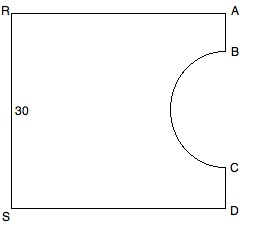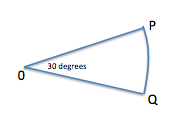All SAT Math Resources
Example Questions
Example Question #1 : How To Find The Area Of A Sector

If B is a circle with line AC = 12 and line BC = 16, then what is the area formed by DBE?
Line AB is a radius of Circle B, which can be found using the Pythagorean Theorem:
Since AB is a radius of B, we can find the area of circle B via:
Angle DBE is a right angle, and therefore 

Example Question #2 : How To Find The Area Of A Sector

The radius of the circle above is 

Area of Circle = πr2 = π42 = 16π
Total degrees in a circle = 360
Therefore 45 degree slice = 45/360 fraction of circle = 1/8
Shaded Area = 1/8 * Total Area = 1/8 * 16π = 2π
Example Question #1 : Sectors


The arc from 


All units are in feet.
The diagram shows a plot of land.
The cost of summer upkeep is $2.50 per square foot.
In dollars, what is the total upkeep cost for the summer?
To solve this, we must begin by finding the area of the diagram, which is the area of the square less the area of the semicircle.
The area of the square is straightforward:
30 * 30 = 900 square feet
Because each side is 30 feet long, AB + BC + CD = 30.
We can substitute BC for AB and CD since all three lengths are the same:
BC + BC + BC = 30
3BC = 30
BC = 10
Therefore the diameter of the semicircle is 10 feet, so the radius is 5 feet.
The area of the semi-circle is half the area of a circle with radius 5. The area of the full circle is 52π = 25π, so the area of the semi-circle is half of that, or 12.5π.
The total area of the plot is the square less the semicircle: 900 - 12.5π square feet
The cost of upkeep is therefore 2.5 * (900 – 12.5π) = $(2250 – 31.25π).
Example Question #2 : Plane Geometry
In the figure, PQ is the arc of a circle with center O. If the area of the sector is 
First, we figure out what fraction of the circle is contained in sector OPQ: 

Using the formula for the area of a circle, 

We can use this to solve for the circumference of the circle, 

Now, OP and OQ are both equal to r, and PQ is equal to 

To get the perimeter, we add OP + OQ + PQ, which give us 
Example Question #11 : Circles
A central angle of a circle measures 60 degrees. If its corresponding arc measures 3 units, what is the area of the circle?
If the central angle measures 60 degrees, divide the 360 total degrees in the circle by 60.
Multiply this by the measure of the corresponding arc to find the total circumference of the circle.
Use the circumference to find the radius, then use the radius to find the area.
Example Question #1 : How To Find The Length Of An Arc

Figure not drawn to scale.
In the figure above, circle C has a radius of 18, and the measure of angle ACB is equal to 100°. What is the perimeter of the red shaded region?
36 + 20π
18 + 10π
36 + 36π
18 + 36π
36 + 10π
36 + 10π
The perimeter of any region is the total distance around its boundaries. The perimeter of the shaded region consists of the two straight line segments, AC and BC, as well as the arc AB. In order to find the perimeter of the whole region, we must add the lengths of AC, BC, and the arc AB.
The lengths of AC and BC are both going to be equal to the length of the radius, which is 18. Thus, the perimeter of AC and BC together is 36.
Lastly, we must find the length of arc AB and add it to 36 to get the whole perimeter of the region.
Angle ACB is a central angle, and it intercepts arc AB. The length of AB is going to equal a certain portion of the circumference. This portion will be equal to the ratio of the measure of angle ACB to the measure of the total degrees in the circle. There are 360 degrees in any circle. The ratio of the angle ACB to 360 degrees will be 100/360 = 5/18. Thus, the length of the arc AB will be 5/18 of the circumference of the circle, which equals 2πr, according to the formula for circumference.
length of arc AB = (5/18)(2πr) = (5/18)(2π(18)) = 10π.
Thus, the length of arc AB is 10π.
The total length of the perimeter is thus 36 + 10π.
The answer is 36 + 10π.
Example Question #1 : Plane Geometry

In the circle above, the angle A in radians is
What is the length of arc A?
Circumference of a Circle =
Arc Length
Example Question #1 : How To Find The Length Of An Arc

In the figure above, 




The formula for arclength is 
You know that 



Since

the sum the lengths of arcs 


Example Question #2 : How To Find The Length Of An Arc

Figure NOT drawn to scale
Refer to the above figure. Evaluate 


Setting 

Example Question #1 : How To Find The Angle Of A Sector
A pie has a diameter of 12". A piece is cut out, having a surface area of 4.5π. What is the angle of the cut?
12.5°
25°
4.5°
45°
90°
45°
This is simply a matter of percentages. We first have to figure out what percentage of the surface area is represented by 4.5π. To do that, we must calculate the total surface area. If the diameter is 12, the radius is 6. Don't be tricked by this!
A = π * 6 * 6 = 36π
Now, 4.5π is 4.5π/36π percentage or 0.125 (= 12.5%)
To figure out the angle, we must take that percentage of 360°:
0.125 * 360 = 45°
Certified Tutor
All SAT Math Resources




































































